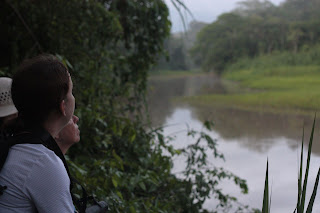At 4:00 am we rise to head out to the clay lick.
The macaws of the Tambopata Reserve were featured in a National Geographic article
in 1994. It highlighted one of the largest clay licks in the jungle, less than
three hundred meters from our lodge. It attracts up to fifteen species of parrots and
macaws, hundreds of birds at a time. They lick the clay in order to add
something, probably salt, to their diets. But they do not come when it rains.
It is dark and I am sleepy. I hear the rain. We are not going.
When it lets up, we go out for a later
hike and see lots of monkeys. We add three more species to our list: Red
Howler, Squirrel, Brown Capuchin. We also see a Blue-throated Piping Guan and a
Razor-billed Curassow, turkey-like birds from the same family. These birds are a
sentimental favorite of mine and they delight me. The sound of a nearby herd of
peccaries captures our attention. We track them and then wait. Suddenly our
guide grabs my shoulders and points me toward them, so that I can get a better
look. I practically climb backward over the top of him to peek out from behind
his shoulder instead. They come close enough to make eye
contact. The Ficus trees are huge and magnificent, also Ironwood and Kapok.
The next morning it is still drizzly but we
head to the clay lick anyway. Quite a few birds arrive despite the less than
ideal conditions. We see a large White Cayman carrying a fresh caught catfish the
size of its own head and climbing out of the river on the bank across from us. It
holds the fish steady for a long while before heading back into the river. They
disappear into the brown water.
It is fun to be a part of this group I am with at last, and our next hike, in the late afternoon, turns into a night walk. Near the equator, the dark falls quickly; there is no twilight to speak of. The jungle at night holds even more secrets than in the daylight and we hear lots of eerie noises. We follow a loud plaintive sound and find the poison arrow frog responsible. We lure a tarantula from its den for a photo op.
It is Friday now and we head out for our final
visit to the clay lick. It is a clear morning and we set up to wait for the
dawn and the birds. They do not disappoint. We see at least ten species of parrots
and macaws. Hundreds of them. Blue-and-Yellow Macaw, Red-bellied Macaw, Scarlet Macaw, Chestnut-fronted Macaw, Blue-headed Macaw, Orange-cheeked Parrot, Blue-headed Parrot, Yellow-crowned Parrot, Mealy Parrot.
The cacophony of their squawking overtakes the
quiet of the dawn. We notice that they arrive in a particular order, the same
order as they did the day before. The rain has kept their numbers down for the
last two mornings, so maybe they are excited to be back. Their
flocking behavior and loud calls are also protection from predators. We
see a Roadside Hawk perched in a tree nearby and so do they.
The time has passed quickly here and by late
morning we are stepping onto the motorized canoes for the trip downriver. It
takes two days to get back to Puerto Maldonado so we will stop over at
Refugio Amazonas. Along the way we watch a capybara family along the bank of
the river. Our spotter thinks he sees a jaguar and we drift toward the
river’s edge to get a look. Long gone.
We arrive in time to get to the canopy tower
before sunset. From our vantage point above the jungle we see patches of crazy bright
blue and identify Paradise Tanagers in the branches below. Our guide laughs as
he tells us about the Americans he brought here who saw those birds and used
the word “ridiculous” to describe them. And so they are, in such gaudy
adornment, seven distinct bright colors in all. We see a Purple-throated
Fruitcrow perched at the top of another tree. This is not actually a crow, but
a member of the Cotinga family, a large group of fruit-eating birds. Looking over the top of the jungle's canopy we watch as the sky turns pink and the sun reflects golden light
below us. It is our final twilight in this magnificent setting.
Our last morning comes and my hammock gently
sways as I look out the open deck of our lodging. The air is thick but not as
hot at this hour. The Pono Palm trees give me a sense of where I am and the sound
of the Screaming Piha has become familiar. He is another cotinga, and after
glimpsing him in the dense woods yesterday I can picture him advertising himself to the females in the area. There are so many remarkable sounds in the
jungle and I wish I could hold on to them. Before long we motor down the
Tambopata River to head out. As I watch the river go by, I already feel homesick
for this awe-inspiring place I am leaving.
 |
| Wikipedia photo - Paradise Tanager |












